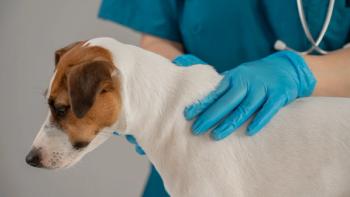
Pseudomonal otitis (Proceedings)
Few organisms elicit as much concern in the field of small animal dermatology as Pseudomonas aeruginosa.
Few organisms elicit as much concern in the field of small animal dermatology as Pseudomonas aeruginosa. It is an opportunistic pathogen, rarely infecting normal, healthy skin or ears. However, the organism is well-suited to adhere to and take advantage of compromised tissue. The resulting infections are often difficult to treat due to bacterial antibiotic resistance. Pseudomonas aeruginosa is a gram-negative, aerobic rod. Most strains are motile by virtue of a single polar flagellum. The organism is commonly found in water, soil and on plant surfaces. In human hospital environments, it is a common nosocomial pathogen accounting for 10% of all hospital-acquired infections. It has minimal nutritional requirements and tolerates a wide variety of physical conditions, enabling it to survive in numerous reservoirs including shampoo bottles, disinfectants, sinks, traps and mops. The optimal temperature for growth is 37° C, but it is able to grow at temperatures up to 42° C.
Pathogenesis
Pseudomonas aeruginosa produces two soluble pigments: fluorescent pyoverdin and blue pyocyanin. Pyocyanin contributes to the organism's virulence, exerting proinflammatory effects on phagocytes and impairing immune functions of epithelial cells. Tissue invasion is aided by extracellular elastase (which can cleave collagen) and alkaline protease (which interferes with fibrin formation). Other soluble proteins that aid virulence include cytotoxin (leukocidin) and hemolysins. Extracellular exotoxins (exoenzyme S and exotoxin A) act to impair phagocytic cells and cause local necrosis.
Both biofilm and planktonic, unicellular forms are found in nature. Biofilm matrix composed of mucoid exopolysaccharide is termed alginate. Biofilms anchor cells to their environment and play an important role in bacterial resistance to host defense mechanisms and antibiotics. Cell-to-cell signaling mechanisms and quorum sensing allow the organisms within the biofilm to act in a coordinated, cell-density dependent manner to confound host defenses. In addition to the protection provided by the slime layer, antibiotic resistance can be conferred by exchanging plasmids by transduction and conjugation.
Treatment
Systemic antibiotics which are often used to fight Pseudomonas aeruginosa infections include aminoglycosides, fluoroquinolones and ceftazidime. Recommended dosages in the dog are given in Table 1.
Table 1: Anti-pseudomonal antibiotics
Topical therapy of Pseudomonas infections may achieve antibiotic concentrations far exceeding those used in susceptibility testing. On the other hand, poor penetration through exudates and biofilms may lead to lower concentrations than expected. Thus, susceptibility testing may not accurately predict clinical efficacy, especially in cases of otitis externa and otitis media. Antibiotics that are commonly used topically to treat pseudomonal infections include gentamicin, neomycin, enrofloxacin, colistin, carbenicillin, ticarcillin and silver sulfadiazine.
Several studies have examined antibiotic resistance of Pseudomonas isolates from the skin and ears of dogs. Multidrug-resistant strains were isolated more frequently from ear isolates than skin isolates over a 6-year period. Ear isolates were more often resistant to gentamicin and amikacin, in particular. There is evidence that fluoroquinolone-resistant strains are increasingly common in human medicine and veterinary dermatology. Lloyd and others compared the susceptibility patterns of canine Pseudomonas isolates during three time periods: 1992 (prior to the introduction of enrofloxacin in the United Kingdom), 1995 and 2003. The percentage of isolates sensitive to enrofloxacin fell from 79% (1992) to 45% (1995) to 15% (2003). A similar reduction in Pseudomonas enrofloxacin susceptibility has been found in other studies.
Otitis externa and otitis media
Pseudomonal otitis almost always occurs in patients with a previous history of otitis externa complicated by other pathogens, such as Malassezia or Staphylococcus. Predisposing, primary and perpetuating factors may all contribute to the progression of a non-pseudomonal secondary infection to a severe, ulcerative infection with Pseudomonas aeruginosa. Factors commonly involved include: excessive moisture and tumors (predisposing factors); atopic dermatitis and foreign bodies (primary factors); and ceruminous gland hyperplasia, tympanic membrane tear and otitis media (perpetuating factors). Chronic treatment of non-pseudomonal infections may also play a role in the development of antibiotic-resistant Ps. aeruginosa otitis.
Therapy should include thorough cleaning of the ear canal. Most often, general anesthesia is required to perform an adequate, deep ear cleaning. A video otoscope greatly aids in assessing the integrity of the tympanic membrane and the thoroughness of the lavage. The author prefers to use saline when otitis media is suspected. Others advocate mixtures of ceruminolytics and saline for ear lavage, followed by saline alone. The ear canal is often quite friable in cases of pseudomonal otitis and care should be taken to cause minimal trauma to the epithelium. Systemic and topical glucocorticoid therapy is often necessary to reduce the severe inflammation associated with the underlying factors that have led to the infection.
As stated previously, the antibiotic susceptibility testing performed will not likely reflect drug levels achievable with topical therapy. Further, the reliability of ear cultures has been brought into question in terms of the identity of organisms recovered, the effect of sample site, and the susceptibility patterns obtained. Nonetheless, susceptibility testing may allow for an informed selection of a topical antibiotic when your first choice has not demonstrated clinical efficacy. Culture and susceptibility testing is also appropriate for selecting systemic therapy, which should be considered particularly for otitis media. One study brought into question whether oral fluoroquinolone therapy at maximum recommended doses was able to achieve the MIC of canine ear isolates. However, anecdotal reports and a report on marbofloxacin monotherapy suggest that they do have a place in the treatment of pseudomonal otitis. Intravenous ticarcillin combined with topical ticarcillin and ear cleaning was reportedly effective in 11 of 12 dogs with multidrug resistant strains of Pseudomonas otitis
There are relatively few commercial topical products appropriate for the treatment of pseudomonal otitis. This has led to the frequent compounding of products within veterinary hospitals. Though often left with no effective commercial alternative, one should keep in mind the uncertain stability of the compounded formulations described in Table 2. Compounding pharmacists can serve as a valuable resource. Silver sulfadiazine is often a good empirical choice when susceptibility data demonstrates a multidrug resistant strain. The author favors using an EDTA-containing ear cleanser (TrizEDTA™, DermaPet) as part of the treatment plan. EDTA is thought to damage the integrity of the bacterial cell wall by chelating metal ions, allowing penetration of antibiotics. Due to the severity of pseudomonal otitis externa, a follow-up evaluation within 7 days is warranted.
Table 2: Ear products and compounded formulations for the treatment of pseudomonal otitis
References
Petersen AD, Walker RD, Bowman MM, et al. Frequency of isolation and antimicrobial susceptibility patterns of Staphylococcus intermedius and Pseudomonas aeruginosa isolates from canine skin and ear samples over a 6-year period (1992-1997). J Am Anim Hosp Assoc. 2002; 38(5): 407-13.
Schick AE, Angus JC, Coyner KS. Variability of laboratory identification and antibiotic susceptibility reporting of Pseudomonas spp. isolates from dogs with chronic otitis externa. Vet Dermatol. 2007; 18(2): 120-6.
Carlotti DN GE, Koch HJ et al. . Marbofloxacin® for the systemic treatment of Pseudomonas spp. suppurative otitis externa in the dog Oxford: Butterworth Heinemann, 1998.
Nuttall TJ. Use of ticarcillin in the management of canine otitis externa complicated by Pseudomonas aeruginosa. J Small Anim Pract. 1998; 39(4): 165-8.
Newsletter
From exam room tips to practice management insights, get trusted veterinary news delivered straight to your inbox—subscribe to dvm360.




